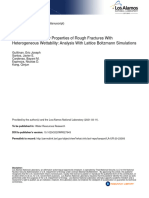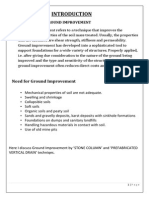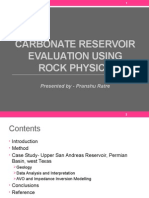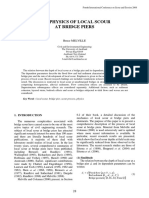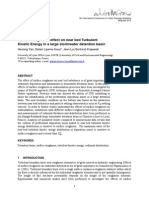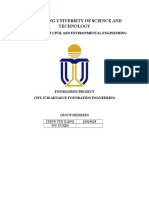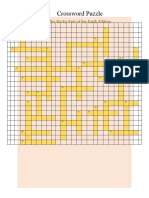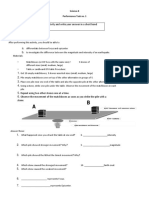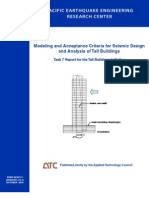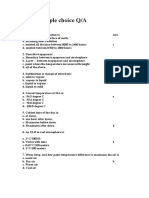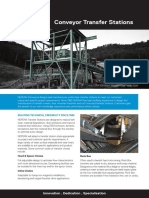0 ratings0% found this document useful (0 votes)
28 viewsJournal Review
Journal Review
Uploaded by
Jun KangThe document discusses several studies on the permeability of soils under different loading conditions:
1) Permeability generally decreases with isostatic or oedometric loading as porosity and clay particle orientation changes, though some studies found no significant permeability change following shear deformation.
2) One study observed permeability depends on prior stress, with over-consolidated sediments showing permeability increases from brittle shear zones, but not under-consolidated sediments.
3) Another study found permeability decreases with confining stress and is correlated to void ratio, while particle size did not significantly impact permeability in gravelly soils.
Copyright:
© All Rights Reserved
Available Formats
Download as DOCX, PDF, TXT or read online from Scribd
Journal Review
Journal Review
Uploaded by
Jun Kang0 ratings0% found this document useful (0 votes)
28 views3 pagesThe document discusses several studies on the permeability of soils under different loading conditions:
1) Permeability generally decreases with isostatic or oedometric loading as porosity and clay particle orientation changes, though some studies found no significant permeability change following shear deformation.
2) One study observed permeability depends on prior stress, with over-consolidated sediments showing permeability increases from brittle shear zones, but not under-consolidated sediments.
3) Another study found permeability decreases with confining stress and is correlated to void ratio, while particle size did not significantly impact permeability in gravelly soils.
Original Description:
a
Copyright
© © All Rights Reserved
Available Formats
DOCX, PDF, TXT or read online from Scribd
Share this document
Did you find this document useful?
Is this content inappropriate?
The document discusses several studies on the permeability of soils under different loading conditions:
1) Permeability generally decreases with isostatic or oedometric loading as porosity and clay particle orientation changes, though some studies found no significant permeability change following shear deformation.
2) One study observed permeability depends on prior stress, with over-consolidated sediments showing permeability increases from brittle shear zones, but not under-consolidated sediments.
3) Another study found permeability decreases with confining stress and is correlated to void ratio, while particle size did not significantly impact permeability in gravelly soils.
Copyright:
© All Rights Reserved
Available Formats
Download as DOCX, PDF, TXT or read online from Scribd
Download as docx, pdf, or txt
0 ratings0% found this document useful (0 votes)
28 views3 pagesJournal Review
Journal Review
Uploaded by
Jun KangThe document discusses several studies on the permeability of soils under different loading conditions:
1) Permeability generally decreases with isostatic or oedometric loading as porosity and clay particle orientation changes, though some studies found no significant permeability change following shear deformation.
2) One study observed permeability depends on prior stress, with over-consolidated sediments showing permeability increases from brittle shear zones, but not under-consolidated sediments.
3) Another study found permeability decreases with confining stress and is correlated to void ratio, while particle size did not significantly impact permeability in gravelly soils.
Copyright:
© All Rights Reserved
Available Formats
Download as DOCX, PDF, TXT or read online from Scribd
Download as docx, pdf, or txt
You are on page 1of 3
Raynaud et al.
(2010)
Most permeability measurements are obtained during isostatic loading or
oedometric loading. Permeability decreases as a function of loading: this is
related to diminishing volume of voids (porosity) and also to the reorientation
of clay particles.
A few studies of the permeability evolution associated with deviatoric
deformation have also been published. These later studies are mainly motivated
by observations in accretionary prisms where ductile shear zones seem to have
important role in fluid migration patterns.
Obviously, the mean average value of radiological density measured on all
cross-section areas is close to the value obtained for the undeformed sample and
corresponds to 45% porosity. That is to say, at the sample scale, the positive and
negative distribution of the porosity variations induced by the stress field are
apparently counterbalanced. This observation is consistent with very low
variation of the volumetric deformation and also consistent with very weak
permeability variation, which is a bulk rock property. In fact, the lack of
significant permeability increase following the intense shear deformation is a
strong argument for stating that zones of increased porosity associated with
shear zones are discontinuous.
The occurrence of shear bands does not appear to modify the initial density
distribution of {001} crystallographic planes. We conclude that the number of
particles, which have been re-oriented by shear, is statistically very weak.
At the particle scale, relative movements of the particles, producing a re-
organisation of the microstructure, account for deformation. (a) There is no
evidence of breakage or damage of the particles. (b) The macroscopic shear
bands are composed of a sandwich of micro-shear bands of reoriented and
non-reoriented particles (5m in width for each band). (c) In the non-reoriented
micro-bands, the elongation plane of the particles remains perpendicular to the
axial loading. In the reoriented micro-shear bands, the particles are turned off
and they tend to be oriented parallel to the macroscopic shear band direction.
Bolton et al. observe that the resulting permeability evolution depends on the
previous stress story of the sample: for under-consolidated sediments, no
significant permeability variation is associated with shear. For over-
consolidated sediments, clear increases of permeability associated with
corresponding porosity growth are attributed to the occurrence of discrete brittle
shear zones.
Despite a strong axial deformation (17%), no significant permeability increase
is seen at the sample scale in the axial direction. This behavior, which could
appear to be strange, is in fact related to the negligible volumetric deformation
of the sample.
Hatanaka et al. (2001)
The coefficient of permeability decreases with increasing confining stress. The
effect of the confining stress can be understood as the effect of the void ratio.
And the small change of the void ratio due to consolidation only leads to a small
change of the coefficient of permeability.
There is no good correlation between the physical properties and the coefficient
of permeability.
The coefficient of permeability of gravelly soils is almost the same as that of
sandy soils, even though the 50% diameter of gravelly soils is about ten to a
hundred times that of sandy soils. This result implies that the large size particles
of gravelly soils are not significant in the permeability characteristics of gravelly
soils.
The effect of the small size particle of the gravelly soils on the coefficient of
permeability was found significant
Duncan (1993)
Difficulties in estimating settlements and settlement rates: evaluating
preconsolidation pressures, selecting values of cv of consolidation rate
calculations, shortcomings in conventional consolidation theory
You might also like
- Slope Engineering For Mountain RoadsDocument9 pagesSlope Engineering For Mountain RoadsDaniel Pasy SelekaNo ratings yet
- Asce 7-22 CH 20 - For PCDocument5 pagesAsce 7-22 CH 20 - For PCsharethefiles100% (1)
- Cambridge Secondary 1 CheckpointDocument12 pagesCambridge Secondary 1 CheckpointDương Ngọc Cường73% (11)
- Basic Drilling FluidsDocument42 pagesBasic Drilling Fluidsmahapatih_51100% (3)
- Burland, J. B. (1973) - Shaft Friction of Piles in Clay - A Simple Fundamental Approach. Ground Engineering, 6 (3), 30-42Document6 pagesBurland, J. B. (1973) - Shaft Friction of Piles in Clay - A Simple Fundamental Approach. Ground Engineering, 6 (3), 30-42Jennifer Miller100% (1)
- ColinSayers Elastic Prop Carbonates 2Document4 pagesColinSayers Elastic Prop Carbonates 2Rodrigo SantosNo ratings yet
- PetrGeosc 2000 Hesthammer Fossen Fault SealingDocument19 pagesPetrGeosc 2000 Hesthammer Fossen Fault SealingRoland Rawlins IgaborNo ratings yet
- Panel and Macro BlockDocument12 pagesPanel and Macro BlockFabián Ricardo Mendoza ZapataNo ratings yet
- Discrete Fracture Network Modeling For Carbonate RockDocument5 pagesDiscrete Fracture Network Modeling For Carbonate RockosemannNo ratings yet
- Flow in A SlabDocument9 pagesFlow in A SlabDavid TorresNo ratings yet
- Fault and Their PotentialDocument6 pagesFault and Their PotentialVann Torng BmcNo ratings yet
- Dolomite LimestonClonSayer PDFDocument4 pagesDolomite LimestonClonSayer PDFMahmoud EloribiNo ratings yet
- Turbulent Flow Characteristics Over An Abrupt Step Change in Bed RoughnessDocument17 pagesTurbulent Flow Characteristics Over An Abrupt Step Change in Bed RoughnessSammelan ChowdhuryNo ratings yet
- Liquefaction Resistance of Fibre-Reinforced Silty Sands Under Cyclic LoadingDocument16 pagesLiquefaction Resistance of Fibre-Reinforced Silty Sands Under Cyclic LoadingSHNo ratings yet
- Two-Phase Fluid Flow Properties of Rough Fractures With Heterogeneous Wettability: Analysis With Lattice Boltzmann SimulationsDocument40 pagesTwo-Phase Fluid Flow Properties of Rough Fractures With Heterogeneous Wettability: Analysis With Lattice Boltzmann SimulationsHussen MohammedNo ratings yet
- Dynamic Wettability Properties of Single Wood Pulp Fibers and Their Relationship To AbsorbencyDocument15 pagesDynamic Wettability Properties of Single Wood Pulp Fibers and Their Relationship To AbsorbencyLatifNo ratings yet
- Permeabilidad, Jiang 2010Document13 pagesPermeabilidad, Jiang 2010Rolanditto QuuisppeNo ratings yet
- Control of Tectonic Setting and Large-Scale Faults On The Basin-Scale Distribution of Deformation Bands in Porous Sandstone (Provence, France)Document18 pagesControl of Tectonic Setting and Large-Scale Faults On The Basin-Scale Distribution of Deformation Bands in Porous Sandstone (Provence, France)AiwarikiaarNo ratings yet
- Bimal Real StoneDocument20 pagesBimal Real StoneমহঃনূরমাওলাNo ratings yet
- The Effect of Displacement Rate On Imbibition Relative Permeability and Residual SaturationDocument17 pagesThe Effect of Displacement Rate On Imbibition Relative Permeability and Residual SaturationhekmatzadehNo ratings yet
- Geochem Geophys Geosyst - 2020 - Rudolph - Bayesian Inference of Mantle Viscosity From Whole Mantle Density ModelsDocument20 pagesGeochem Geophys Geosyst - 2020 - Rudolph - Bayesian Inference of Mantle Viscosity From Whole Mantle Density ModelsTorel Samyuktha S 21291No ratings yet
- Finite Element Analysis For Isolated Pile FoundationDocument12 pagesFinite Element Analysis For Isolated Pile FoundationAbhay SinghNo ratings yet
- Geotechnics 04 00018Document13 pagesGeotechnics 04 00018Yani Putri AgustinaNo ratings yet
- Wall Adhesion and Constitutive Modelling of Strong Colloidal GelsDocument41 pagesWall Adhesion and Constitutive Modelling of Strong Colloidal Gelsdaniel.lesterNo ratings yet
- Guo2012 LR 8Document19 pagesGuo2012 LR 8rakeshmanna815No ratings yet
- An Analytical Study of The Effect of Penetration Rate On Piezocone Tests in ClayDocument27 pagesAn Analytical Study of The Effect of Penetration Rate On Piezocone Tests in ClayMarcus ViniciusNo ratings yet
- Elston_etal_2022_Non-steady-state slip rates emerge along evolving restraining bends under constant loadingDocument5 pagesElston_etal_2022_Non-steady-state slip rates emerge along evolving restraining bends under constant loadingSoohyun.BaeNo ratings yet
- Sedimentology - 2020 - Yan - Controls On Fluvial Meander Belt Thickness and Sand Distribution Insights From Forward PDFDocument30 pagesSedimentology - 2020 - Yan - Controls On Fluvial Meander Belt Thickness and Sand Distribution Insights From Forward PDFSofia Carolina AvellanedaNo ratings yet
- Paper - Angulo de Friccion BasalDocument41 pagesPaper - Angulo de Friccion Basalpercy matiuNo ratings yet
- Assignment 9Document5 pagesAssignment 9Engr MahwishNo ratings yet
- Influence of Microphysical Variability On Stochastic Condensation in A Turbulent Laboratory CloudDocument13 pagesInfluence of Microphysical Variability On Stochastic Condensation in A Turbulent Laboratory CloudAtif KhanNo ratings yet
- Experimental Study of The Particles Influence On The Pyramid Wake Within The Turbulent Boundary LayerDocument12 pagesExperimental Study of The Particles Influence On The Pyramid Wake Within The Turbulent Boundary LayerEsraa GaberNo ratings yet
- Bolton 1986 - The Strength and Dilatancy of SandsDocument14 pagesBolton 1986 - The Strength and Dilatancy of SandsCristian SandovalNo ratings yet
- 2.4 Factors Affecting Sonic Waves and Dynamic Elastic Properties 2.4.1 Matrix Minerals EffectsDocument10 pages2.4 Factors Affecting Sonic Waves and Dynamic Elastic Properties 2.4.1 Matrix Minerals Effectsmahmood jassimNo ratings yet
- 10 1002@esp 5012Document61 pages10 1002@esp 5012dzulizzatjulaihiNo ratings yet
- A numerical analysis of the shear behavior of granular soil with finesDocument13 pagesA numerical analysis of the shear behavior of granular soil with finesYutang ChenNo ratings yet
- s11242-024-02092-xDocument26 pagess11242-024-02092-xAjendra SinghNo ratings yet
- Carbonate Reservoir Evaluation Using Rock PhysicsDocument27 pagesCarbonate Reservoir Evaluation Using Rock Physicsniksr91No ratings yet
- Ma et al. - 2023 - Study on the seepage mechanisms of rock with bifurcation fractures under confining pressureDocument13 pagesMa et al. - 2023 - Study on the seepage mechanisms of rock with bifurcation fractures under confining pressurefalla85No ratings yet
- PorosityDocument25 pagesPorosityMichael AndersonNo ratings yet
- Effects of Sediment Grain Size and Channel Slope On The Stability of River BifurcationsDocument15 pagesEffects of Sediment Grain Size and Channel Slope On The Stability of River BifurcationsHưng Huỳnh TấnNo ratings yet
- The Critical State Friction Angle of Granular Materials: Does It Depend On Grading?Document15 pagesThe Critical State Friction Angle of Granular Materials: Does It Depend On Grading?pnNo ratings yet
- Three-Dimensional Simulation of Rivulet and Film Flows Over An Inclined Plate: Effects of Solvent Properties and Contact AngleDocument39 pagesThree-Dimensional Simulation of Rivulet and Film Flows Over An Inclined Plate: Effects of Solvent Properties and Contact AngleKsenia ProtcenkoNo ratings yet
- Fracture Processes: Residual Strength of Kaolin and Bentonite: The Influence of 951056Document1 pageFracture Processes: Residual Strength of Kaolin and Bentonite: The Influence of 951056Issam SembatiNo ratings yet
- The Influence of Discontinuity Orientation On The Behaviour of TunnelsDocument8 pagesThe Influence of Discontinuity Orientation On The Behaviour of TunnelsNadim527No ratings yet
- Melville 2008 The Physics of Local ScourDocument13 pagesMelville 2008 The Physics of Local ScourKuswandi Andi100% (1)
- Novak ShetaDocument19 pagesNovak ShetaWendy CohenNo ratings yet
- Lingkungan PengendapanDocument9 pagesLingkungan PengendapanAnonymous qGmxokVFgYNo ratings yet
- Reservoir HeterogeneityDocument55 pagesReservoir HeterogeneityMohammed MizbauddinNo ratings yet
- Macam2 Arah Tunjaman Sunda-BandaDocument11 pagesMacam2 Arah Tunjaman Sunda-BandaErwin SetiawanNo ratings yet
- 1 s2.0 S0012821X18306915 MainDocument14 pages1 s2.0 S0012821X18306915 MainJorge D. MarquesNo ratings yet
- Bioturbation 1Document8 pagesBioturbation 1jorgepierNo ratings yet
- Han Et Al 2008Document7 pagesHan Et Al 2008B RAMUNo ratings yet
- Outcrop-Aided Characterization of A Faulted Hydrocarbon Reservoir: Arroyo Grande Oil Field, California, USADocument20 pagesOutcrop-Aided Characterization of A Faulted Hydrocarbon Reservoir: Arroyo Grande Oil Field, California, USAMursid SulistyoNo ratings yet
- Session B.2 - 3.2Document21 pagesSession B.2 - 3.2sasa.vukojeNo ratings yet
- Transition Between Regimes of A Vertical Channel Bubbly Upflow Due To Bubble DeformabilityDocument13 pagesTransition Between Regimes of A Vertical Channel Bubbly Upflow Due To Bubble DeformabilitySubhajit BiswasNo ratings yet
- Seg-2005-0364 PDFDocument5 pagesSeg-2005-0364 PDFleonelz6aNo ratings yet
- Lecture-3 - Tortuosity of Porous Network - 24.08.2017Document15 pagesLecture-3 - Tortuosity of Porous Network - 24.08.2017PEEYUSH GARGNo ratings yet
- Sukhodolov 2017Document30 pagesSukhodolov 2017Luis F. CastroNo ratings yet
- SPE-166505 Defining Three Regions of Hydraulic Fracture Connectivity in Unconventional ReservoirsDocument14 pagesSPE-166505 Defining Three Regions of Hydraulic Fracture Connectivity in Unconventional ReservoirsFabricetoussaintNo ratings yet
- Chu 1989Document11 pagesChu 1989Sujiwo SthNo ratings yet
- Constitutive Modeling of Soils and RocksFrom EverandConstitutive Modeling of Soils and RocksPierre-Yves HicherRating: 5 out of 5 stars5/5 (1)
- Project CIVL5110Document2 pagesProject CIVL5110Jun KangNo ratings yet
- Stockwell TransformDocument5 pagesStockwell TransformJun KangNo ratings yet
- Stop SignboardDocument1 pageStop SignboardJun KangNo ratings yet
- Stop SignboardDocument1 pageStop SignboardJun KangNo ratings yet
- FEM2Document1 pageFEM2Jun KangNo ratings yet
- Project CIVL 5720Document12 pagesProject CIVL 5720Jun KangNo ratings yet
- 1 1 1 + 2 3 sin 2 π 3 sin θ sin 2 π 3: K - G modelDocument2 pages1 1 1 + 2 3 sin 2 π 3 sin θ sin 2 π 3: K - G modelJun KangNo ratings yet
- Progress Report of Final Year ProjectDocument10 pagesProgress Report of Final Year ProjectJun KangNo ratings yet
- CIVL5720 Group Assignment 2015Document1 pageCIVL5720 Group Assignment 2015Jun KangNo ratings yet
- W Mass of Water Mass of Soil Solids M M: PN PP SN Ns S TC BC FP RM CH TsDocument2 pagesW Mass of Water Mass of Soil Solids M M: PN PP SN Ns S TC BC FP RM CH TsJun KangNo ratings yet
- LQRZ, Pauline Crossword P (Worksheet)Document2 pagesLQRZ, Pauline Crossword P (Worksheet)Reaper UnseenNo ratings yet
- Science 8 Performance Task No. 1Document3 pagesScience 8 Performance Task No. 1Kathleen Dando100% (1)
- Principles of Building Design: DPWH Field Engineers CourseDocument72 pagesPrinciples of Building Design: DPWH Field Engineers CoursenathanNo ratings yet
- Softening Behavior - Fred Et - Al.Document8 pagesSoftening Behavior - Fred Et - Al.rowa.fangNo ratings yet
- Draw and Describe A LandscapeDocument1 pageDraw and Describe A LandscapeProf_CuriousNo ratings yet
- Book Review: Expansive Soils-Problems and Practice in Foundation and Pavement EngineeringDocument2 pagesBook Review: Expansive Soils-Problems and Practice in Foundation and Pavement EngineeringABDIRAHMANNo ratings yet
- Vedic River Sarasvati and Hindu CivilizationDocument408 pagesVedic River Sarasvati and Hindu CivilizationvishwaNo ratings yet
- Welcome To BIOL 1001: Evolution, Ecology, Biodiversity and ConservationDocument62 pagesWelcome To BIOL 1001: Evolution, Ecology, Biodiversity and Conservationlame321No ratings yet
- Web PEER2010 111 ATCDocument245 pagesWeb PEER2010 111 ATCLuu Quang Hieu100% (1)
- JET Multiple Choice Q/ADocument7 pagesJET Multiple Choice Q/ADipanjan ChoudhuryNo ratings yet
- Elenin and Earthquakes Pt1 enDocument41 pagesElenin and Earthquakes Pt1 en21xim21100% (1)
- Bander BlockDocument2 pagesBander BlockSecond SpaceNo ratings yet
- BplanschsyllDocument34 pagesBplanschsyllJdohndlfjbdNo ratings yet
- Conveyor Transfer Stations 2Document2 pagesConveyor Transfer Stations 2tubagus syariefNo ratings yet
- Leng Etal 2012 LithosphereDocument14 pagesLeng Etal 2012 LithosphereIsidora Cantuarias YurasNo ratings yet
- Estimation of Clarks Instantaneous Unit Hydro Graph in GISDocument9 pagesEstimation of Clarks Instantaneous Unit Hydro Graph in GISSudharsananPRS100% (1)
- What Rome Was Built WithDocument124 pagesWhat Rome Was Built WithPaulaNo ratings yet
- Geotechnical Factors Influencing Selection of Mining MethodDocument4 pagesGeotechnical Factors Influencing Selection of Mining MethodMichael AltamiranoNo ratings yet
- Erratum: Gulf Petrolink, BahrainDocument1 pageErratum: Gulf Petrolink, BahrainSardar Saleem Fatah KarimNo ratings yet
- Global Cement Industry CompetitiveDocument20 pagesGlobal Cement Industry CompetitiveBarikly Robby100% (1)
- CompleteDocument7 pagesCompleteJasmine MendozaNo ratings yet
- TechnicalExams Dec2017Document29 pagesTechnicalExams Dec2017ming_zhu10No ratings yet
- Park, J-W. Et Al. (2019)Document14 pagesPark, J-W. Et Al. (2019)WilliamsRafaelMataRimacNo ratings yet
- SEPM Society For Sedimentary Geology Paleontological SocietyDocument6 pagesSEPM Society For Sedimentary Geology Paleontological SocietyChristian LópezNo ratings yet
- Analyzing Coastal Vulnerability Index Using IntegrDocument7 pagesAnalyzing Coastal Vulnerability Index Using IntegrPrayogiNo ratings yet














